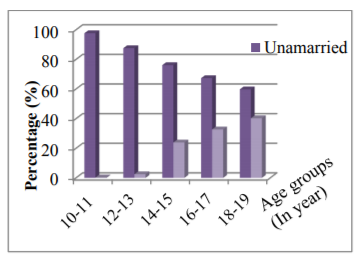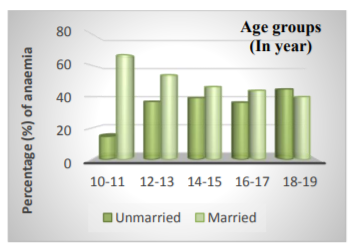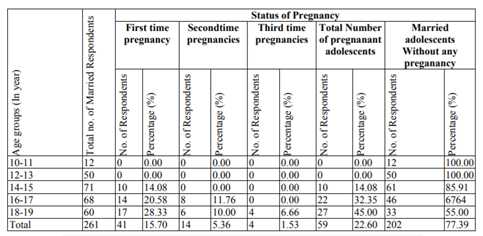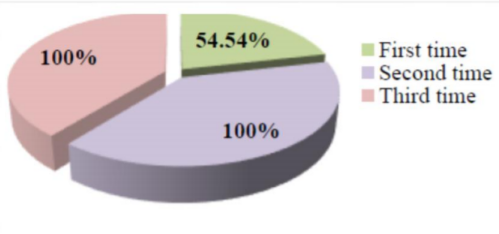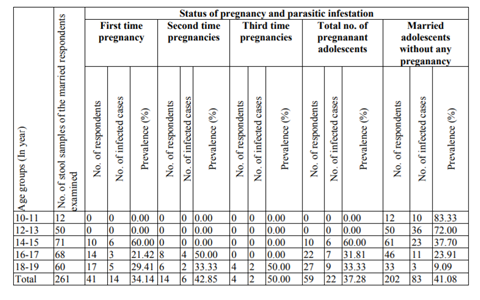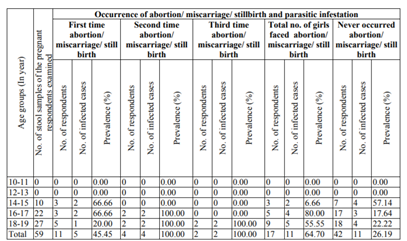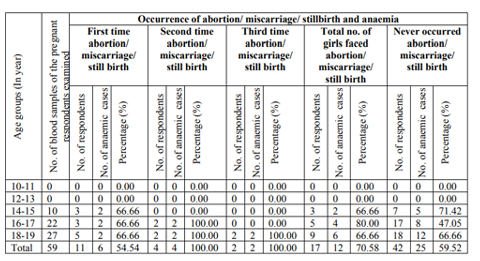Information
Journal Policies
Reproductive Health of the Adolescent Girls: Parasitic Infestation and Anaemia
Hasina Banu1*, Hamida Khanum1
Copyright : © 2018 Authors. This is an open-access article distributed under the terms of the Creative Commons Attribution License, which permits unrestricted use, distribution, and reproduction in any medium, provided the original author and source are credited.
The present study was conducted on 1570 adolescent girls (aged 10-19 years) in rural, urban and slum areas in and around Dhaka city to investigate the association of parasitic infestation with anaemia and reproductive status of them. About one third (33.50%) of the adolescent girls were found to be infected with protozoan and helminth parasites. Anaemia was reported 32.22% among the adolescent girls and was higher (46.74%) among the married than unmarried girls (29.15%) which was statistically significant (p< 0.000). Anaemia was highest (70%) among pregnant girls of 14-15 years’ age while, the married girls found the highest (40.26%) in age group of 18-19 years. Highest prevalence of infestation (83.33%) was observed among the married girls in the age group of 10-11 years. But in case of unmarried girls, highest prevalence (42.45%) was in the age group 12-13 years. Highest pregnancy rate (45%) was observed in 18-19 years and 6.66% of the married adolescent girls experienced their third time pregnancy. Pregnant girls with abortion/ miscarriage/ stillbirth history was significantly associated (χ2=6.12, p< 0.01) with parasitic infection. The exposure (pregnant girls who were faced abortion/miscarriage/stillbirth) was positively associated with parasite infection (OR=5.17 and risk of exposure was 2.47 times higher risk than nonexposured to cause parasitic infection.
Adolescent girls, anaemia, parasitic infestation, early marriage, pregnancy,Public Health and Community Medicine
1. Introduction
The transitional period from childhood to adulthood is commonly called adolescence. As defined the World Health Organization (WHO, 1997), “Adolescence is the period of life between 10 and 19 years of age”. Specific biological changes occur during adolescence. In girls, this is the time when physiological preparation for motherhood takes place Adolescents constitute about 20% of the total population in the countries of South East Asia including Bangladesh (WHO 2006).
The problem of poor dietary iron intake is the traditional practice of early marriage in many countries of the SEA Region (DHSs and Thailand MICS 2005-06)/ (WHO, 2011). Onset of pregnancy during adolescence further increases demands for iron and contributes to aggravating iron deficiency and IDA. In India 47% and in Bangladesh and Nepal over 50% girls are married by the time they are 18 years of age. In Indonesia, Thailand and Sri Lanka girls are married by 18. Early marriage is frequently associated with early pregnancy (WHO 2011).
The frequent occurrence of infectious diseases and parasitic infestation among developing countries further increases requirements for iron, chances of negative iron status and IDA. The prevalence of anaemia was double infested girls (53.6%) compared to those who were not infected (25%) (WHO, 2011). In Asia and Latin America, roundworm and hookworm infections rank after tuberculosis and diarrhoeal diseases (Polowski 1984). In Bangladesh, As. lumbricoides, An. duodenale, T. trichura, Enterobius vermicularis and E. histolytica, Giardia lamblia are common (Rowsan, 1993; Banu et al., 2003; D’Silva et al., 2003; Uddin et al., 2005; Khanum et al., 2008, Banu et al., 2011, Banu et al., 2013). Multiple infections with several different parasites are common and their harmful effects are often aggravated by coexistent malnutrition or micronutrient deficiencies (WHO, 2002). In Bangladesh it was found that 58-90% of 4-13 years old children harboring As. lumbricoides and 60% of 1-40 years old people suffer from E. vermicularis infection (Banu et al., 2003; D’Silva et al., 2003). WHO (1994) and Lee et al. (2000) reported iron deficiency anaemia during acute infections with malarial parasites and chronic infections of intestinal parasites with with the hemoglobin status of human hosts.
Intestinal helminth infection affects millions of women of reproductive age in developing countries (Gillespie and Johnston, 1998). Hookworms cause chronic intestinal blood loss by attaching the mucosa of intestine and ingesting tissue and blood, and it was estimated that some 44 million women were both pregnant and infected with hookworm (Bundy et al., 1995). Infection during pregnancy could compromise maternal perinatal health and nutritional status (Weigel et al., 1996; Santiso 1997). Prevalence of anaemia among pregnant women in developing countries average 56% with a range of 35% to 100% among various regions of the world (WHO, 1992). South Asian regional anaemia prevalence has been estimated to be 75% among pregnant women, the highest in the world (WHO, 1998). The prevalence of anaemia to be 73% in Nepal with 88.9% women infected with helminths (Dreyfuss et al. 2000). Anaemia in pregnancy is considered one of the major risk factors contributing to maternal deaths in developing countries (AbouZahr and Royston, 1991). Haemorrhage, eclampsia and infections were the three major causes of maternal deaths. Since it reduces resistance to blood loss, death may occur from bleeding associated with normal delivery.
The reproductive cycle in pregnancy, childbirth and lactation are nutritionally demanding and adolescent mothers face these demands while they are still growing and developing (Tanner 1990). Adolescent pregnancy probably contributes to the very high maternal fetal mortality rates in the developing countries (Harrison et al. 1985). Teenage mothers are an increased risk of having preterm deleveries and stillbirth. This is attributed to the competition between extra demand of the fetal growth and requierements for maintaining skeletal maturation and menarche (Naeye 1981).
Young still growing adolescent even when match for nutritional status, have asmaller newborns than adult mothers (Frisancho et al., 1985). Uddin et al. (2005, Sanderowitz 1995) reported high prevalence of anaemia (96.87%) among the infested adolescent girls. Helen Keller International/ Institute of Public Health Nutrition (1999) through National Vitamin A suggest that 43% of adolescent girls were anaemic. The present study was undertaken to investigate the prevalence of parasitic infestation, anaemia and reproductive status of the adolescent girls from rural, urban and slum settings of Bangladesh and to correlate the relevant parameters.
2. Materials And Method
The present investigation was a cross sectional study with a sample size of 1570 adolescent girls (aged 10-19 years) conducted during the period of June 2006 to May 2009. Six study areas are located in Dhaka District, Bangladesh representing rural (Kamrangirchar and Zinjira), urban (Savar and Lalbag) and slum areas (Mirpur and Mohammadpur). Faecal and blood samples were collected from adolescent girls and carried to the laboratory. The most recommended Formol Ether Concentration Method (Cheesbrough, 2004) was used for faecal sample examination and Finger prick blood was collected from each adolescent to measure their hemoglobin level instantly in the field with sahli hemoglobinometer according to WHO (1992, 1994).
3. Results And Discussion
The present investigation was conducted to determine their gastrointestinal parasitic infestation, measurement of hemoglobin to determine the level of anaemia, nutritional status, reproductive health condition, socioeconomic aspects.
Percentage of married adolescent girls was found to increase with the increase of age. An abroupt increase was observed from 12-13 to 14-15 years’ age group when the percentage of married girls rose from 2.43% to 23.9%. The highest percentage (40.26%) of married girls was found in age group 18-19 years (Figure. 1).
Highest prevalence of infestation (83.33%) was observed among the married girls in the age group of 10-11 years followed by 72% in 12-13 years age category. But in case of unmarried girls, highest prevalence (42.45%) was observed in the age group 12-13 years. The prevalence of anaemia was higher in rural areas where 58.13% and 57.14% of the married girls were found to be anaemic in Kamrangirchar and Zinzira respectively (Table 1). In the present observation, percentage of anaemia was much higher among the married girls than the unmarried grls in each age group as well. It was also noted that the highest percentage of anaemia from married adolescent girls who got marry in too early period of age (Table 1).
Marital status of the adolescent girls was significantly associated (χ2=6.00, p< 0.01) with parasite infection. The exposure (married girls) was positively associated with parasite infection (OR=1.42). Risk of exposure was 1.25 times higher risk to form parasitic infection than non exposure (unmarried girls). Percentage of Anaemia among married and unmarried girls recorded as 46.74% and 29.15% respectively. The difference was statistically significant (χ2=29.40, p< 0.000). The results (OR=2.11) showed that exposure (married girls) was positively associated with anaemia. Risk of exposure was 1.59 times higher risk to cause anaemia than the non exposure (unmarried girls). Occurrence of anaemia was highest (66.66%) among married adolescent girls in 10-11 years age groups whereas less prevalence (14.74%) was found in unmarried girls in the same age group (Table1; Figure. 2).
Among all age groups, the highest pregnancy rate (45%) was observed in 18-19 years and 6.66% of the married adolescent girls experienced their third time pregnancy. Among all of married girls, 22.60% were experienced in pregnancy at different frequency (Table 2; Figure. 3). Although, lowest cases of pregnancy were observed in 14-15 years’ age group but the percentage of parasitic infection was highest (60%) in that age groups. In contrast, total number of adolescent girl’s experience in pregnancy was higher in the age group 18-19 year while the prevalence of infestation was found lower (33.3%) than the age group 14-15 years (Table 2). Percentage of anaemia among the all age group was recorded as 62.71%. The highest (70%) anaemic cases were observed in 14-15 years’ age group followed by 66.66% anaemic cases belonged to the 18-19 years’ age category.
The highest percentage of pregnancy was 45% among the married adolescent girls aged 18-19 years Pregnancy status of the adolescent girl was not found significantly associated (χ2=2.27, p>0.05) with parasite infection. The exposure (pregnant girls) was not positively associated with parasite infection (OR=0.61 and risk of exposure was 0.75 times higher risk than non exposure (not pregnant) to form positive parasitic infection (Table). Pregnancy status of the adolescent girls was highly significantly associated (χ2=7.00, p< 0.008) with Anaemia. The exposure (pregnant girls) was positively associated with Anaemia (OR=2.3) and risk of pregnant girls 1.43 times higher risk to cause Anaemia than non exposers (not pregnant girls) cause Anaemia (Table 2).
It appears, a remarkable percentage of pregnant adolescent girls faced abortion/ miscarriage/ stillbirth during their pregnancy. Out of total pregnant girls of all age groups, 30.5% were found to experience abortion/ miscarriage/ stillbirth. Age specifically, 18-19 years’ group showed highest rate (33.33%) of abortion/ miscarriage/ stillbirth. It was revealed that parasitic infection was very much common among the pregnant girls who frequently faced abortion/ miscarriage/ stillbirth. The highest prevalence (80%) of infestation was noted in 16-17 years’ age group. Overall prevalence among all age groups was 64.7% (Table 3 and 4).
Minimum third time abortion / miscarriage/ still birth were prevalent among 16-19 years’ girls. Hundred percent of the girls were found to be Anaemic who were faced second to third time abortion/ miscarriage/ stillbirth (Table 4). It is evident from the figure 17, the Anaemic cases increased drastically with the frequency of the abortion/ miscarriage/ still birth. Hundred percent (100%) of the girls were aneamic who faced second to third time of abortion/ miscarriage/ still birth. Pregnant girls with abortion/ miscarriage/ stillbirth history were significantly associated (χ2=6.12, p< 0.01) with parasitic infection. The exposure of among the adolescent girls in relation to different age groups. pregnant girls who were faced parasite infection (OR=5.17 and risk of exposure was 2.47 times higher risk than non exposured girls to cause parasitic infection (Table 5). The exposure was positively associated with anaemia (OR=1.63) and risk of pregnant girls suffered from abortion/ miscarriage/ stillbirth 1.3 were times in higher risk to cause anaemia than non exposers.
The prevalence of anaemia is disproportionately high in developing countries due to poverty, inadequate diet, risky and high frequency of pregnancy and lactation and poor access to health services. Adolescent girls are particularly susceptible because of their rapid growth and associated high iron requirements. It was also investigated that relative impacts of protozoan and helminth infections on nutrition, maraital status, risky pregnancy, abortion/ miscarriage/ stillbirth as well as socio economic condition and their personal hygiene etc. may play role on rising parasitic infection and anaemia.
Large invsetigation have found that almost half of all women aged 20-24 are married by the age of 15 in Bangladesh, as are nearly one-fourth in India (24%) and one-fifth (19%) in Nepal. In Nepal, the median age at first marriage amongst girls is 16.4 years and in India, 24% of girls below 18 years are found to be married (WHO, 2006).
In the present study, 59 (22.6%) respondents experienced different frequency of pregnancies (Table 4, 7 and 8). Adolescent pregnancy is a worldwide problem, with 25% of women having their first child by the age of 19 years (Senderowitz, 1995). Despite the lower number of pregnant girls, the prevalence of parasitic infestation among them cannot be ignored (37.2%). Comparatively higher prevalence (60%) of infestation was observed among the adolescent girls who experienced their first pregnancy in the early age of 14-15 years. In an Indonesian study, much higher prevalence (69.7%) was reported (Nurdiati et al. 2001).
In the present study among the pregnant adolescent, 62.71% was found to be anaemic (table 9) which lower than Indian pregnant women (70%). Decline in hemoglobin during pregnancy is partly due to hemodilution combinedly with rapid mobilization of maternal iron stores. Frequent pregnancy as well as poor consumption of heme iron and promoters of non heme iron absorptions togethr with high consumption of inhibitors of non heme iron absorptions lowers these reserves. However, anaemia in tropical countries has multiple contributory causes. Iron deficiency has been shown to be major cause. Moreover, the role of hookworm and T. trichura in causing iron blood loss and reduce absorption (Roche and Layrisse, 1966; Layrisse et al., 1987; Pritchard et al., 1991; Crompton and Whitehead, 1993).
Anaemia often observed in pregnant adolescents who have poor nutritional and low socioeconomic status. Adolescent fertility rates found higher in Bangladesh, Bhutan, India and Nepal (WHO, 2006). Although, in present study, 16.62% adolescent girls were married, prevalence of parasitic infestation was comparatively higher than unmarried adolescent girls which eventually led higher incidence of anaemia. Parasitic infestation among the married adolescent who experienced their first pregnancy at the early age of 14-15 years was much higher (60%) and anaemia was alarmingly higher (62.71%) among them which might be due to faulty dietary habit, poor maternal reserve of iron and parasitic infestation (Figure. 1 and Table 9).
4. Conclusion
The findings of the present study clearly indicate that anaemia was significantly higher (35%) amongst the infected adolescent girls than the non infected girls (30.6%) which reaffirms the fact that parasitic infection is one of single most contributory factors of anaemia among the adolescent girls. Although 16.62% adolescent girls were married, prevalence of parasitic infestation was comparatively higher among them than unmarried adolescent girls which eventually led higher incidence of anaemia among the married girls.
The most important and striking findings of the present study was influence of parasitic infestation among the married adolescent who experienced their first pregnancy at the early age of 14-15 years was much higher (60%). Moreover, the prevalence of anaemia was alarmingly higher (62.71%) among the pregnant adolescents which might be due to faulty dietary habit, poor maternal reserve of iron and the burden of parasitic infestation. All of the pregnant adolescent girls (100%) who experienced more than one time of abortion/ miscarriage/ stillbirth had anaemia and parasitic infestation. The adolescent girls of the rural and slum areas were more vulnerable to parasitic infestation than urban adolescent girls due to the differences in hygienic conditions, rate of literacy, malnutrition, status of anaemia, risky pregnancy and prevailing socioeconomic condition.
Acknowledgement
We acknowledge to the authority of the University of Dhaka and to the Ministry of National Science and Information & Communication Technology (NSICT), Bangladesh for providing the financial support to continue this research work as a part of Ph D dissertation.
References
- AbouZahr, C. and Royston, E.1991. Maternal mortality: A global fact book. World Health Organization, Geneva. Pp 606. Banu, H., D’silva, J. and Islam, N. 2003. Epidemiological factors and pinworm infection in children. Bangladesh J. Zool. 31(2): 243-246.
- Banu, H. Khanum, H. and Hossain, A.M. 2011. Parasitic infestation among the adolescent girls of Bangladesh. 22nd National Congress of Parasitology. Deptt. of Zoology, Kalyani University, Kalyani, W.B. (pages 91-97). International.
- Banu, H. and Khanum, H. 2013. Intestinal Parasitosis with Anemia and Nutritional Status: Adolescent Girls of Bangladesh. LAMBERT Academic Publishing (LAP) GmbH & Co. KG Heinrich-Böcking-Str. 6-8 66121, Saarbrücken, Germany. Pp 308. (BOOK) International.
- Banu, H. and Khanum, H. 2014. Association of Anaemia and parasitic infestation among the adolescent girls in Bangladesh. Bang. J. Zool. 42(1): 91-103.
- Bundy, D.A.P., Chan M.S. and Savioli, L. 1995. Hookworm infection in pregnancy. Trans. R. Soc. Trop. Med. Hyg. 89: 521-2.
- Cheesbrough, M. 1987. Medical Laboratory Manual for Tropical Countries. Blackworth Co Publishers. Pp570.
- Crompton, D.W.T. and Whitehead, R. 1993. Hookworm infections and human iron metabolism. Parasitology. 107: S137-45.
- D’Silva, J., Banu, H. and Islam, N. 2003. Pinworm infection in children and their personal habits. Dhaka Univ. J. Biol. Sci. 12(2): 193-198.
- Dreyfuss, M.L., Stoltzfus, R.J., Shreshtha, J.B., Pradhan, K.B., Leclerq, S.C. and Khatry, S.K. 2000. Hookworms, malaria and Vitamin A deficiency contributes to anemia and iron deficiency among pregnant women in the plains of Nepal. J. Nutr. 130: 2527-36.
- Frisancho, A.R., Matos, J., Leonard, W.R. and Yaroch, L.A. 1985. Developmental and nutritional determinants of pregnancy outcome among teenagers. Am. J. Physi. Anthrop. 66: 247-261Gillespie, S. and Johnston, J.L. 1998. Expert consultation on anemia determinants interventions. Ottawa: Micronutrient Initiative, Canada. Pp 1-37.
- Harrison, K., Fleming, A., Briggs, N. and Rossiter, C. 1985. Growth during pregnancy in Nigerian teenage primigravidae. Brit. J. Obstet. Gynecol. 92(Suppl 5):32-39.
- Helen Keller International/ Institute of Public Health Nutrition (HKI/ IPHN). 1999. Iron deficiency anemia throughout the life cycle in rural Bangladesh. National vitamin A survey 1997-98. Int. J. Epidemiol. 28: 8-10.
- Khanum, H., Ahmed, S., Uddin, M.H., Rahman, A.B.M.M., Dey, R.R. and Farhana, 2008. Prevalence of intestinal parasites and anemia among the slum male children in Dhaka city. Dhaka Univ. J. Biol. Sci. 17(2): 137-145
- Layrisse, M., Aparcado, L., Martinez-Torres, C. and Roche, M. 1987. Blood loss due to infection and with Trichuris trichiura. Am. J. Trop. Med. Hyg. 16: 613-9.
- Lee, K.J., Ahn, Y.K. and Young, T.S. 2000. A small scale survey of intestinal parasite infection among children and adolescents in Legaspi city, Philippines. Korean J. Parasitol. 38(3): 183-185.
- Naeye, R.L. 1981. Teenaged and preteenaged pregnancies: consequences of the fetal maternal competition for nutrients. J. Pediatr. 67: 146-150.
- Nurdiati, D.S., Sumarni, S., Suyoko, Hakimi, M. and Winkvist, A. 2001. Impact of intestinal helminth infection on anemia and iron status during pregnancy: a community based study in Indonesia. Intestinal helminth infection in pregnancy. Southeast Asian J. Trop. Med. Public Health. 32(1): 14-22.
- Pawlowski, Z.S. 1984. Implications of parasite-nutrition interactions from a world perspective. Fed. Proc. 43: 256-260.
- Pritchard, D.I. 1996. Do haematophagous parasites secrete superoxide dismutase and promote blood flow? Int. J. Parasitol. 26: 1339-40.
- Roche, M. and Layrisse, M. 1966. The nature and causes of hookworm anemia. Am. J. Trop. Med. Hyg. 15: 1031-1100.
- Rowsan, A. 1993. Prevalence of intestinal helminthes and its impact on nutritional status of under 5 years’ children in two urban dispensaries of Dhaka city. DCM Dssertation, NIPSOM. Pp80.
- Santiso R. 1997. Effects of chronic parasitosis on women’s health. Int J Obstet Gynaecol. 58: 129-36.
- Senderowitz J. 1995. Adolescent health: reassessing the passage to adulthood. World Bank Discussion Paper No. 272, Washington, D.C. World Bank. Sharma, A., Prasad, K. and Rao, K.V. 2000. Identification of an appropriate strategy of control anemia in adolescent girls in poor communities. Inian Pedatr. 37: 261-267.
- Tanner, J.M. 1990. Foetus into man: physical growth from conception to maturity. Harvard University Press, Cambridge, Massachusettes, U.S.A.
- Uddin, M. H., Rahman, M. M. and Khanum, H. 2005. Hemoglobin level among adolescent girls and its relation to intestinal parasites. Bangladesh J. Zool. 33(2): 183-187.
- Weigel, M., Calle, A., Armijos, R.X., Vega, I.P., Bayas, B.V. and Montenegro, C.E. 1996. The Effect of chronic intestinal parasitic infection on maternal and perinatal outcome. Int. J. Gynecol. Obstet. 52: 9-17.
- World Health Organization/WHO. 1992. Health of school children: Treatment of intestinal helminthes and schistosomiasis and soil transmitted helminthes. WHO/CDS/IPI/CTD 92.1 Geneva, Switzerland.
- World Health Organization/WHO. 1994. Report of the WHO informal consultation on hookworm infection and anemia in girls and women. WHO/ CTD/ SIP/ 96. 1. 1-46.
- World Health Organization/WHO. 1997. The sex and age distribution of the world populations: The 1996 revision. New York: United Nations.
- World Health Organization/WHO. 2002. Reducing risks promoting healthy life. WHO Rep.
- World Health Organization/WHO. 2006. Adolescent Nutrition: A Review of the Situation in Selected South-East Asian Countries. Pp 96.
- WHO. 2011. Prevention of Deficiency Anaemia in Adolescents: Role of Weekly Iron and
- Folic Acid Supplementation Iron. SEA-CAH-02. Pp 1-50.





